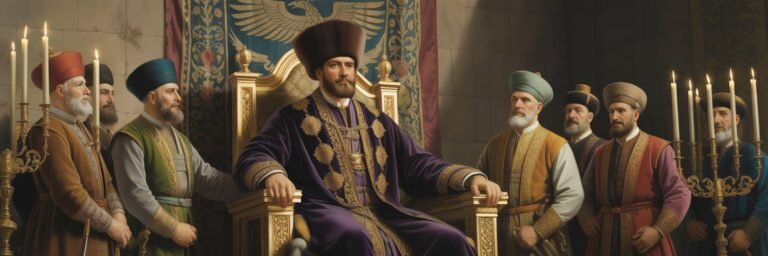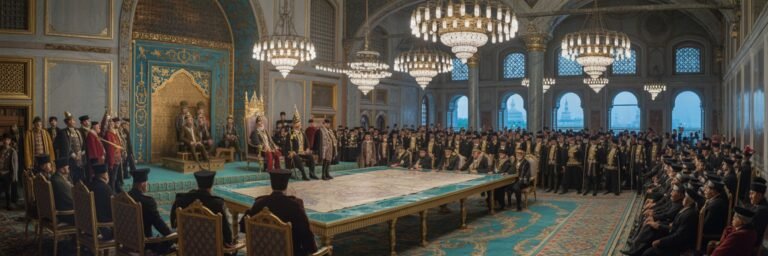INTRODUCTION
From its humble beginnings in the swaddle of the Anatolian plains, the Ottoman Empire erupted from the precincts of a minor Turkic Sultanate into one of the world’s most iconic superpowers. From the 14th century to the early 20th century, the Ottoman Empire reigned, leaving indelible imprints on the fields of warfare, politics, comparativism, and culture.
HISTORICAL BACKGROUND
The Ottoman Empire was established by Osman I around 1299 in northwestern Anatolia. His dynamic rule presented an energizing new spiritual and political vision, sewing seeds for an empire that would dominate large swaths of Europe, Asia, and Africa. The empire’s expansion reached a pinnacle under Suleiman the Magnificent in the 16th century, often seen as its golden age. Suleiman’s rule represented a zenith of Ottoman art, culture, military prowess, and administrative intricacies.
He was known as the “Lawgiver”, expounding Kanuni (law codes) that not only shaped Ottoman space but also influenced broader Islamic and European legal traditions. Ottoman expansion into Europe occurred primarily through military conquests, asserting dominance over Byzantine Constantinople, Serbian Belgrade, and even Hungarian Mohacs.
THEORIES AND INTERPRETATIONS
There are varied theories and interpretations that seek to explain the rise of the Ottoman Empire. The ghazi thesis posits that the empire’s rise was a product of a holy war (ghaza), inspiring warriors to wage battles against non-Muslim entities. Others, however, propose the Borderlands theory, emphasizing geostrategic aspects. This theory argues that the empire’s location at the crossroads of East and West fostered interactions that fuelled it to emerge as a crucible of cultures and a powerhouse. Another line of inquiry has been the role of military technological advancements, particularly the use of cannon artillery, in cementing Ottoman superiority.
In terms of decline, the most prevalent theory is relative decline theory, which contends that the empire did not necessarily fall in absolute terms but was surpassed by other rising powers, especially Western European nations. Other explanations focus on internal decay factors, such as corruption, rebellions, and weakening of the central power.
MYSTERIES AND CONTROVERSIES
The historical journey of the Ottoman Empire is not without its share of mysteries and controversies. The empire’s religious pluralism—Millet-system—which allowed religious communities to govern themselves under their own laws, draws both praise and criticism. Some argue it facilitated tolerance while others contend that it institutionalized second-class citizenship.
The empire is also marred by controversy regarding its handling of ethnic minorities, most notably the Armenians during World War I. The genocide resulted in the massacre and displacement of around 1.5 million Armenians, a somber chapter that continues to provoke intense debate.
SYMBOLISM AND CULTURAL SIGNIFICANCE
The symbols of the Ottoman Empire were varied and powerful. The tughra, a calligraphic monogram or signature of the Sultan, embodied ultimate authority. The crescent and star acquired unique prominence as the emblem of the empire, and Islam in particular.
Culturally, the empire was a melting pot of traditions, owing to its vast territorial expanse. It nurtured a unique form of architecture, exemplified by the Hagia Sophia’s conversion into a mosque, and cuisine, with Turkish coffee and kebab becoming delectable symbols of cultural amalgamation.
MODERN INVESTIGATIONS
Modern investigations into Ottoman history are increasingly interdisciplinary. Scholars often amalgamate archival research with theoretical frameworks from socio-political sciences, linguistics, and anthropology to unveil multi-faceted aspects. For instance, Caroline Finkel in her acclaimed work “Osman’s Dream” provides a nuanced analysis of the empire from a wide array of sources, including Ottoman court chronicles.
In recent times, the role of women, such as Hurrem Sultan or Mihrimah Sultan, in Ottoman history (once relegated to the background) is being reevaluated, adding refreshing new dimensions to our understanding.
LEGACY AND CONCLUSION
The legacy of the Ottoman Empire pervades many spheres of modern life. Its administrative apparatus, the Millet System, has been viewed as a feasible model of pluralism. Additionally, Ottoman law, especially its land laws, significantly influenced modern Middle Eastern legal systems.
Culturally, Ottoman legacy is cherished through its blend of art, music, and literature that cements its place in World History. Although the empire faced a rocky dissolution with the establishment of modern Turkey, Mustafa Kemal Ataturk, the founder of the Republic of Turkey, acknowledged that they “are the heirs of an Empire which, for centuries, has guaranteed peace and justice on three continents.”
The story of the Ottoman Empire is the story of amalgamation—of cultures, peoples, traditions, and ideas. From the battlefields of Kosovo to Istanbul’s majestic skyline, the empire’s pulse, like the melodious strains of the ney, continues to permeate the annals of history, war, peace, and human civilization at large.






